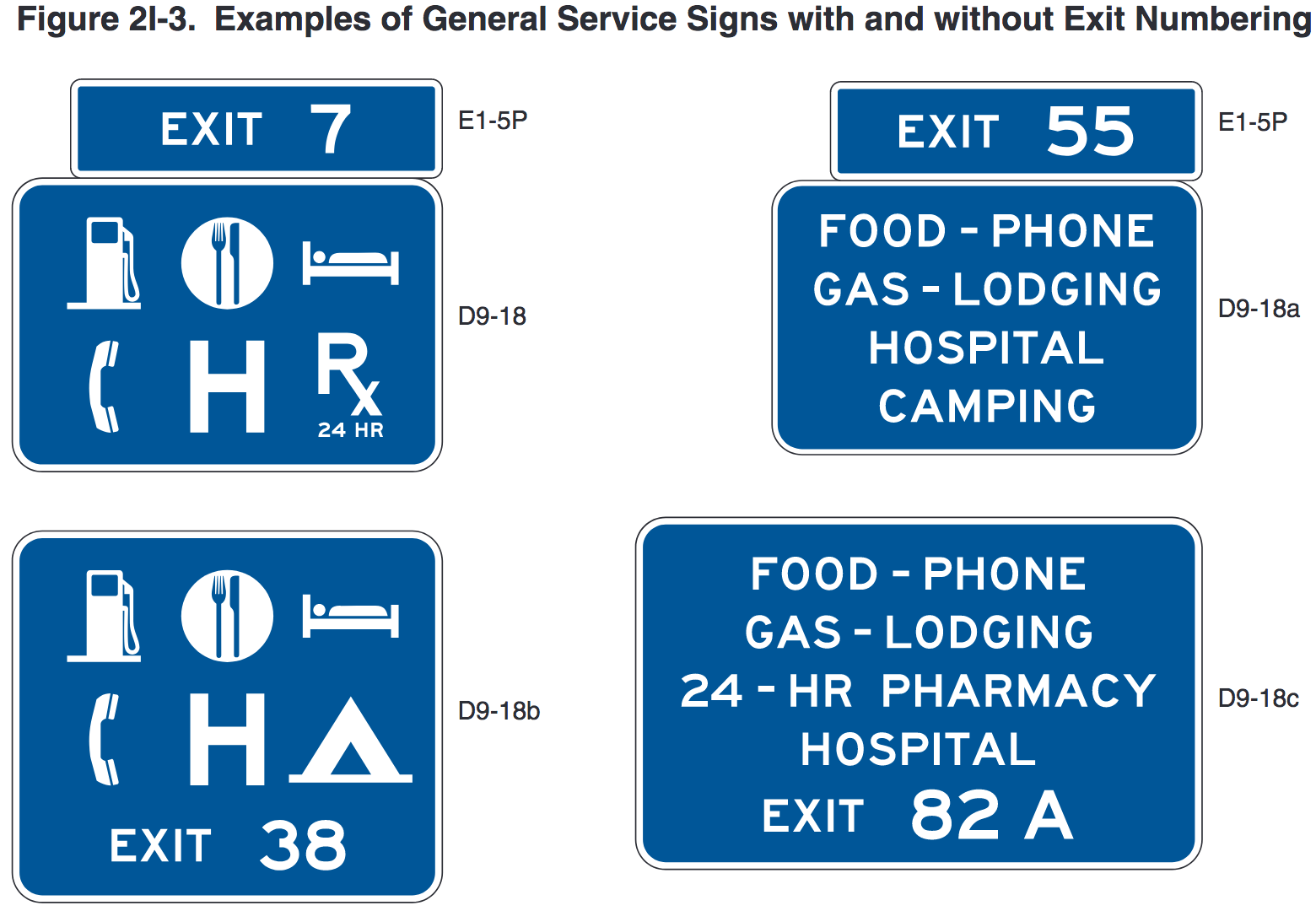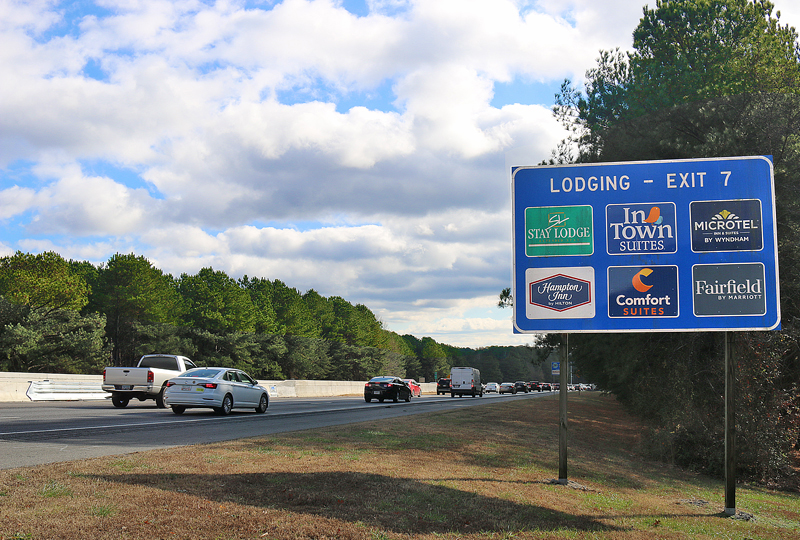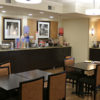Note: This article pertaining to What Is Tourist-Oriented Directional Signing — and Why You Should Not Always Trust It was originally published on Saturday, December 14, 2019 at 10:19 in the evening and has been updated.
If you have driven along the highways of the United States, you have undoubtedly seen those blue signs on the sides near exits to direct you to facilities which sell lodging, food, fuel, camping and attractions nearby — and they display the familiar logos of the companies which are featured on the signs.
What Is Tourist-Oriented Directional Signing — and Why You Should Not Always Trust It

Those signs are known as tourist-oriented directional signing — and because they use the official typefaces and colors as mandated by the Manual on Uniform Traffic Control Devices — or MUTCD — of the Federal Highway Administration of the Department of Transportation of the United States, they look official…
…and they are official — but they differ from general service signs which direct motorists to such generic services as food, fuel, lodging, telephone and hospital…

…in that companies pay money to advertise on tourist-oriented directional signing to get your business.
Two types of tourist-oriented directional signing exist…

…the full-sized ones which are known as mainline and are located on the side of the highway itself — such as the one shown in the photograph above for dining options…

…and smaller ones which are known as ramp and are located on the side of an exit ramp — such as the one shown in the photograph above for dining options and the directions and distances towards where they are located.

As an example, the photograph above shows tourist-oriented directional signing which guides motorists to options of where to purchase fuel off of Exit 7 of Interstate 575 south in the state of Georgia…

…but on this particular exit ramp from an Interstate highway, notice how the tourist-oriented directional signing guides motorists to a variety of different fuel stations — up to as much as three miles away — even though a Chevron station is straight ahead and is the closest one to the exit ramp. This may be because the proprietors of the Chevron fuel station probably see no need to advertise on tourist-oriented directional signing, as the Chevron sign is clearly visible not only from the exit ramp; but also from both directions of the Interstate highway.

Sometimes not enough participants are available to advertise on tourist-oriented directional signing, which leads to the sharing of such signs.

On the sign shown in the above photograph, notice how residue in the top middle indicates evidence that a third company which sells fuel was once on the sign but is now no longer there.
Specifics Pertaining to Tourist-Oriented Directional Signing
Interstate Logos, L.L.C. is a company which manages tourist-oriented directional signing on highways in 24 states — including the state of Georgia — and the province of Ontario.
In the state of Georgia, for example, advertisers pay a flat annual participation fee per direction of $1,000.00 for mainline signage and $200.00 for ramp signage — so if advertisers want to pay for signage in both directions at a particular exit, double the aforementioned amounts…
…but not just any company can simply pay to advertise on tourist-oriented directional signing. A minimum of eligibility criteria must be met by companies in the state of Georgia — each state has its own list of minimum eligibility criteria — in order to qualify to participate in advertising on tourist-oriented directional signing as follows:
- Eligible service establishments may not discriminate on the basis of race, religion, sex, nationality or creed
- All participants shall be approved and licensed by the appropriate state agency or political entity
- Certain conditions may allow a business not meeting all criteria to participate under a variance, which the company that wants to advertise must contact Georgia Logos L.L.C. for variance information
GAS
- Offer unleaded gasoline, oil, water
- Provide free clean, sanitary, easily identifiable and accessible restroom facilities
- Provide telephone nearby and available for public use
- 12 hours per day, 7 days per week
- Maximum distance to service: 2 miles
FOOD
- Continuous operation to serve 2 meals per day, 6 days per week and be open a minimum of 10 hours per day with operational hours beginning by 11:00 in the morning
- Indoor seating for at least 12 people
- Public restroom facilities
- Public telephone
- Maximum distance to service: 2 miles
LODGING
- Continuous operation 24 hours per day, 7 days per week
- Must offer a minimum of 20 sleeping units, off street parking and accessible public telephone
- Each sleeping unit must provide a private entrance and restroom which has hot and cold water with a minimum of a tub or shower
- Maximum distance to service: 2 miles
CAMPING
- Continuous operation 7 days per week during business season with provisions for registering campers 24 hours per day. For those campgrounds operating on a seasonal basis, their business logo sign will be removed or covered at season’s end.
- Minimum of 12 campsites
- Modern sanitary facilities within or immediately adjacent to the campground
- Drinking water
- Public telephone
- Provide adequate accommodations for all types of travel trailers, camping or recreational vehicles, and tents
- Maximum distance to service: 5 miles
ATTRACTIONS
- Continuous operation 5 days per week in season (except the “Arena” category). For those businesses operating on a seasonal basis, their business logo sign shall be removed or covered at season’s end.
- Adequate parking
- Provide sanitary public restroom facilities
- Telephone available for public use
- Be compliant with guidelines of the Americans with Disabilities Act
- Be of regional interest to the traveling public and qualify in a participating category
- The company that wants to advertise must contact Georgia Logos L.L.C. for additional information pertaining to Attraction eligibility requirements
- Maximum distance to service: 5 miles and have a route that can be easily navigated by motorists
PHARMACY
- Continuous operation 24 hours per day, 7 days per week
- State-licensed pharmacist present and on duty at all times
- Maximum distance to service: 3 miles
Summary

Tourist-oriented directional signing generally does a good job of guiding motorists to available services at a particular exit off of a highway — but keep in mind that although they will save you time, they may not necessarily be the best options for you. You do not know the direction, distance or price of the service which is offered by a specific company until you have exited the highway and are driving on the ramp while decelerating — and the managers of the businesses likely are hoping that you say, “Well, I am here already, so I may as well use the service before returning to the highway.”
You may want to use software application programs for such things as maps or fuel prices to research what exactly are your options prior to embarking on your trip.
In the meantime, a list of pricing options for each different state — as well as links to their dedicated official Internet web sites — are listed below at the conclusion of this article; and as the list is not complete at this time, please keep checking back as states are added to the list and more photographs are added to this article.
Readers of The Gate have sharp eyes; so here is a small challenge for you: now that you have read the minimum criteria to qualify for advertising on tourist-oriented directional signing within the state of Georgia, what do you notice is wrong with the photograph of signage which advertises for fuel on the exit ramp? Please post your answer in the Comments section below.
All photographs ©2019 by Brian Cohen.
COLORADO LOGOS
Annual Fees Per Direction
0 – 9,999 Average Daily Traffic Count — $750
10,000 – 29,999 Average Daily Traffic Count — $900
30,000 – 59,999 Average Daily Traffic Count — $1,200
60,000 and Above Average Daily Traffic Count — $1,500
Fees are inclusive of Mainline and Ramp business logo
Additional fees may apply for fabrication and installation of the actual business logos
GEORGIA LOGOS
Annual Fees Per Direction
$1,000.00 — Mainline
$200.00 — Ramp
KANSAS LOGOS
Annual Fees Per Direction
$1,000.00 — Mainline
$200.00 — Ramp
0 – 19,999 Average Daily Traffic Count
$900 Mainline | $100 Ramp | $1,000 Total
20,000 – 49,999 Average Daily Traffic Count
$1,400 Mainline | $100 Ramp | $1,500 Total
50,000 – 99,999 Average Daily Traffic Count
$1,800 Mainline | $100 Ramp | $1,900 Total
100,000+ Average Daily Traffic Count
$2,300 Mainline | $100 Ramp | $2,400 Total
Additional fees may apply for fabrication and installation of the actual business logos

